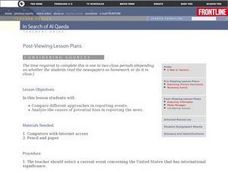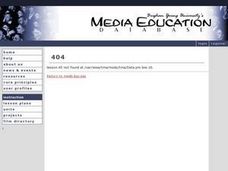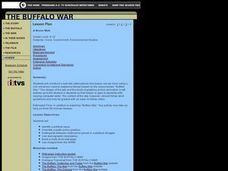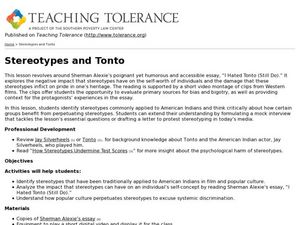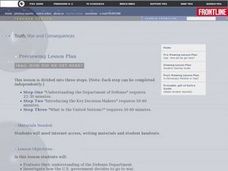Curated OER
Whose Religion Is It?
Learners analyze the impacts of religious expectations on gender roles. In this gender equity instructional activity, students compare and contrast different religions in societies in order to understand the cultural influences and...
Curated OER
Journalism: Potential Bias
Learners investigate a current event involving the United States from different journalistic viewpoints. They compare a Western newspaper with one from the Middle East and submit written evaluations noting agreements and disagreements in...
Curated OER
Exploring Ethnic Groups in Africa
Students research the ethnic groups located in African countries where African Americans immigrated. They view a multi-media presentation imbedded in this plan, then construct posters that represent ethnic groups.
Curated OER
Empowered Barbie
Learners access prior knowledge of vocabulary on feminism and psychoanalytic theory, and gender schema. In this Empowered Barbie lesson, students recreate a Barbie doll. Learners write a reflection on how they changed Barbie's body and...
Curated OER
Exploring Racism in America
Students examine racism, stereotypes, and biases in their personal lives and in the U.S. media. They discuss examples of racism, exploring the types of stereotypes and biases that still exist in our society. They access a multi-media...
Described and Captioned Media Program
Malcolm X: Make It Plain, Part II
Track the transformation of Malcolm Little into Malcolm X and then into El Jajj Malik El-Shabazz with the second part of Make it Plain, a documentary on the famous civil rights activist. Viewers consider not only how events shaped and...
Teaching Tolerance
Community Newsletter
What does it take to develop and publish a newsletter? Young academics create a newsletter with original artwork for their school or community. They explore social justice themes and spread messages of tolerance and inclusion. Scholars...
Curated OER
The Media
Students explore political advertising. They discuss what informed voters should know about upcoming elections and identify the four main types of ads and view a video to identify the types of ads. Evaluating the ads, they identify...
Columbus City Schools
Asexual and Sexual Reproduction
Can you name a type of reproduction that produces no variation in the offspring? The multimedia lesson covers both sexual and asexual reproduction through videos and discussions. It includes topics such as genetic modification, meiosis,...
Curated OER
Defining Moments: Analyzing Data
Students create an annotated bibliography on writings related to Japanese internment and analyze the writings for possible bias. They view a video on the Korematsu Internment case and use the internet to find print and non-print sources...
Curated OER
What Do Halloween Costumes Say?
Students analyze Halloween costumes they find in magazines to categorize their findings. In this holiday lesson, students discuss their findings about the costumes based on four different elements.
Curated OER
The Real World Revisited
Class members participate in a series of hands on, online, and multimedia activities to identify the difference between primary and secondary sources. They watch a related video and visit a variety of sites to locate primary and...
Curated OER
Alien Visitor's Rewrite
Pupils role play the role of an alien who analyzes how the media represents the different social groups. In groups, they write their own story in which they add or revise a character to make it non-stereotypical. They share their...
Curated OER
What Makes a Cat a Cat?
Learners investigate the lives of pets by videotaping them. In this animal life lesson, students videotape a cat and other pets using school cameras in a computer lab. Learners review the footage from the cat and other animals and...
Curated OER
Phenomenology Lesson Plan #1
Students approach media with a phenomenological criticism. They recongize biases that they have and where they have come from. They also identify biases in professional work.
Curated OER
Phenomenology Lesson Plan #5: Character Part 2
Students examine the meaning of the word icon as it relates to media and pop culture. They watch and discuss film clips, write a mini-biography, take a Film Icon Quote quiz, and write a written response to the film clips.
Curated OER
Broadcast from the Past
Students will be responsible for presenting (either performing live or videotaping and playing) a newscast dealing with an aspect of the Civil Rights Movement that connects to the unit topic of media and social justice. During the...
Curated OER
The Lynching of Emmett Till
Pupils will be introduced to the historiography of the Emmett Till murder to discover more about the case and to evaluate how history is reliant on interpretation. They will also refine analytical and critical thinking skills as they...
Curated OER
A Bison Web
High schoolers view a documentary on the treatment of the buffalo. In groups, they create a website using ideas and solutions they developed. They must include graphics or animation and a multi-level webpage. They share their pages...
Curated OER
Political Science: Political Analysis Through Satire
Students identify, analyze and explain examples of politcal satire. They discuss the role of political satire in the democratic process and create and present examples of political satire.
Curated OER
It’s a Big, Big World
Students examine the role of the explorers. In this explorers and conquistadors, students create word puzzles (Wordles) regarding the time period in history. Students conduct research regarding a particular explorer and create foldables...
Curated OER
The "Ad" Survey-What Makes a Print Ad Convincing?
Students develop opinions from a variety of materials, recognize and analyze bias, propaganda and stereotypes, and evaluate effectiveness of print advertisements.
Curated OER
Stereotypes and Tonto
Students identify stereotypes, especially those applied to American Indians. In this teaching tolerance lesson, students read an essay entitled " I Hated Tonto (Still Do)" and discuss the negative impact that stereotypes may have on a...
Curated OER
Iraq: How Did We Get Here?
Students examine the role of the Department of Defense. They explain the process in which the government decides it is going to go to war with another country. They identify key decision makers and explore the role of the United Nations.



